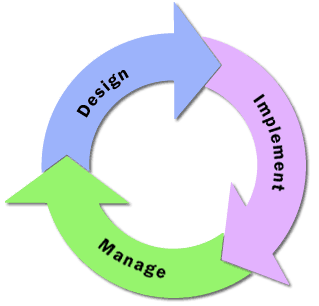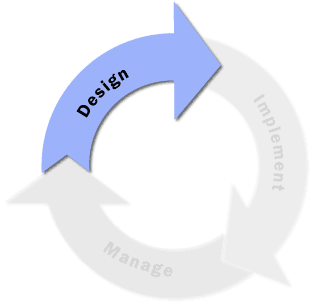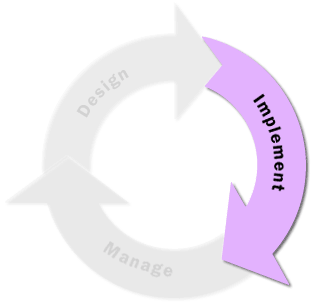| Lesson 2 | Introduction to networking services design |
| Objective | Introduce the basic model of a networking services design cycle. |
Networking Services Design
Networking designs vary widely in their overall structure. However, all networking designs share common characteristics.
The first such characteristic is the deployment cycle. Here, deployment refers to the process of planning and implementing a networking solution. For example, you deploy a WINS server solution when you plan and then install WINS servers throughout your network in order to provide fault-tolerant NetBIOS
name resolution services for your NetBIOS network applications.
- WINS: Windows Internet Name Service. The name of the Microsoft NetBIOS Name Service. A WINS Server resolve NetBIOS names to IP addresses.
- NetBIOS: A session layer interface used to allow NetBIOS applications to work properly on TCP/IP based networks.
The cycle used for deploying networking services into a network consists of three main phases:
- Design
- Implementation
- Management

You can further divide each of these phases by the specific steps they require you to take. We will explore these below.
Design

A comprehensive design consists of several essential decisions. You will need to consider the following questions listed in the table below.
| What network services will you select? | This decision will require knowledge of the existing infrastructure and current organizational goals. |
| How will you combine the services? | Combining services is necessary for improving the administration and performance of the network. |
| What will your management strategy be? | Your management strategy ensures that the design specifications are met on a day-to-day basis. It must also specify actions taken when the network fails to meet the design specifications. As a network administrator, your job focuses primarily on network management tasks. |
These questions are central to this course and to the overall deployment process.
Implementation

After you have created and satisfactorily tested your design, you are ready to implement the network design.
During this phase of the process, the network is configured to meet the specifications of the design. For example, the network architect will have created a plan for placing WINS servers at strategic locations throughout the enterprise. (The architect'ss plan includes specifications such as the type of processor, the amount of RAM, and the size of hard disks that need to be included in the WINS servers.) During the implementation phase, these WINS servers are actually installed and placed on the network.
At this phase, no testing or management has yet begun. Once the plan specifications are in place, management processes are put into place.
Management

This is the last phase of the deployment process. Here, you begin collecting data on the day-to-day operation of the network.
This knowledge allows you to determine which actions are required to maintain the network within design specifications.
If the network characteristics significantly differ from the design specifications, you may need to redesign the solution.
For example, after implementing a WINS solution based on the planned design, you might find that the specifications on the location or hardware of the WINS server is inadequate because of a new NetBIOS client/server application that has been introduced on the network. In this case, a redesign of the network architecture may be in order. Now that you can describe the overall deployment process, you can begin to design a network foundation. In the next lesson, you will acquire the skills to initiate that process-defining networking components.
For example, after implementing a WINS solution based on the planned design, you might find that the specifications on the location or hardware of the WINS server is inadequate because of a new NetBIOS client/server application that has been introduced on the network. In this case, a redesign of the network architecture may be in order. Now that you can describe the overall deployment process, you can begin to design a network foundation. In the next lesson, you will acquire the skills to initiate that process-defining networking components.